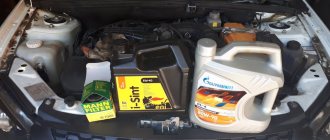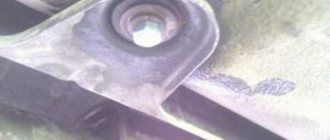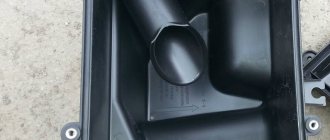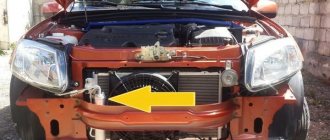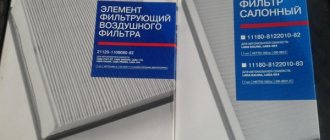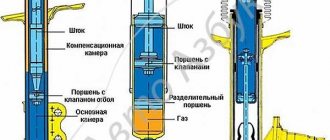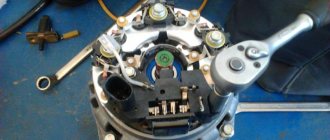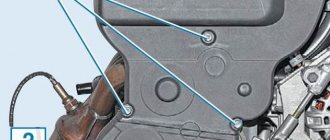Maintenance problems
If any malfunctions occur, you should contact service as soon as possible. By not paying attention to battery failures, you may miss the moment when it can be replaced for free. Then, in addition to the cost of maintenance work, you will also have to pay for replacing the battery. It's better not to make such mistakes.
Grant engines are currently filled with semi-synthetic motor oil at the factory. Since 2013, the features and conditions of maintenance have changed, now you don’t need to change the oil so often (previously, the time to change the technical fluid came after every 3,000 km). If your Granta has a 16-valve engine, then your first maintenance occurs only after 15,000 km. For cars with an 8-valve power unit, it does not require an oil change, but the valves must be adjusted.
During the first service, the Grants can adjust the headlights; if the light beam falls a little lower than expected, check the lambda probe.
In order not to overpay and risk the quality of the lubricant, buy the oil yourself
However, it can be difficult to guess with service in the sense that some enterprising dealers charge inflated fees for such a thing as changing the engine oil, and for the oil itself, which is cheaper to buy in a store and bring to the service station yourself, which is what many Lada owners do.
If possible, achieve the right to be present during service work so as not to disturb the staff, but to see the progress of the work. This is especially important if you live in a small city, where the number of car services is small and there is almost nothing to choose from. It’s easier for residents of large cities; they can take advantage of the advice and reviews of other drivers.
Despite all the riskiness of doing your own maintenance, it can help you save up to half the amount you pay in the end. But you can take it on only with good experience and knowledge. The warranty will not be voided just because you did the repairs yourself. And even the service technician can make a mistake. Another thing is whose mistake will be easier and cheaper to correct.
Please note that the dealer may impose additional services on you. Concentrate only on what is included in the list of necessary works. Moreover, all these procedures do not at all cancel things that are required by regulations. For example, if for some reason you are offered to replace the spark plugs out of turn, and at the next maintenance they need to be updated according to the service book, then you will have to pay for it again.
If you brought any parts and materials for servicing the Lada Granta, they must have a certificate of conformity. Otherwise you will be denied. But if you have the necessary document, no technician has the right, for example, to refuse to fill in the antifreeze you offer. Good luck!
Maintenance schedule and work performed
By following the established schedule and performing the required list of work, you will maintain the machine in optimal technical condition.
Having studied the basic information about maintenance for cars of the Lada Granta line, it is worth taking a separate look at when the first maintenance of the car is carried out, how the 8-valve version differs from the 16-valve version, and what list of works is relevant for this or that maintenance.
If there is a 16-valve engine under the hood, TO-0 is not required, nor is it necessary to make any entries in the service book.
For 8-valve engines installed on Lada Granta, as part of zero maintenance, only valve adjustment is required. This is done in the period from 2 to 3 thousand kilometers.
| the name of the operation | Mileage or duration of operation (thousand km/years, whichever comes first) | |||||||
| 2,5 | 15 | 30 | 45 | 60 | 75 | 90 | 105 | |
| 1 | 2 | 3 | 4 | 5 | 6 | 7 | ||
| Engine and its systems | ||||||||
| Checking the absence of extraneous knocks and noises when the engine is running | + | + | + | + | + | + | + | + |
| Tightening of fastenings of engine parts, components and assemblies | + | — | + | — | + | — | + | — |
| Checking and adjusting thermal clearances in the timing drive of an 8-valve engine | + | — | — | + | — | — | + | — |
| Checking exhaust toxicity | + | + | + | + | + | + | + | + |
| Changing the oil and oil filter | + | + | + | + | + | + | + | + |
| Checking the tightness of cooling, power and exhaust systems. Assessment of the condition of hoses, pipelines, connections | — | + | + | + | + | + | + | + |
| Checking the condition of the generator drive belt | + | + | — | + | — | + | — | + |
| Replacing the alternator drive belt | — | — | + | — | + | — | + | — |
| Checking the condition of the accessory drive belt and replacing if necessary | + | + | + | + | + | + | + | + |
| Checking the condition of the timing belt of a 16-valve engine and replacing if necessary | — | + | + | + | + | + | + | + |
| Checking the condition of the timing belt of an 8-valve engine | — | + | + | + | + | — | + | + |
| Replacing the timing belt of an 8-valve engine | — | — | — | — | — | + | — | — |
| Replacing the air filter element | — | — | + | — | + | — | + | — |
| >Replacing spark plugs | — | — | + | — | + | — | + | — |
| Replacing the fuel filter | — | — | + | — | + | — | + | — |
| Coolant replacement* | — | — | — | — | — | + | — | — |
| Replacing oxygen concentration sensors | — | — | — | — | — | + | — | — |
| Checking the performance of the engine control system | + | + | + | + | + | + | + | + |
| Transmission | ||||||||
| Checking the clutch pedal travel and gear shift accuracy | + | + | + | + | + | + | + | + |
| Checking the absence of extraneous knocks and noises during operation of the clutch, gearbox, and front wheel drives | + | + | + | + | + | + | + | + |
| Tightening the fastenings of transmission components and assemblies | + | — | + | — | + | — | + | — |
| Checking the oil level in the gearbox and the tightness of the unit | — | + | + | + | + | — | + | + |
| Changing the gearbox oil | — | — | — | — | — | + | — | — |
| Checking the condition of protective covers and hinges of the front wheel drives, transmission control rod and gearbox torque rod | — | + | + | + | + | + | + | + |
| Chassis | ||||||||
| Tightening the fastenings of the front and rear suspension elements | + | — | + | — | + | — | + | — |
| Checking the front wheel alignment angles | + | — | + | — | + | — | + | — |
| Checking the condition of the front and rear suspension elements | — | + | + | + | + | + | + | + |
| Checking the condition of the wheels and tires, rearranging the wheels according to the diagram | — | — | + | — | + | — | + | — |
| Steering | ||||||||
| Checking the serviceability of the steering column tilt adjustment mechanism | + | + | + | + | + | + | + | + |
| Checking the total steering play | — | + | + | + | + | + | + | + |
| Checking the condition of the tie rod end joints, their covers and the steering gear cover | — | + | + | + | + | + | + | + |
| Checking the absence of extraneous knocks and noises in the steering mechanism | + | + | + | + | + | + | + | + |
| Checking the serviceability of the electric power steering | + | + | + | + | + | + | + | + |
| Adjusting the gap in the gear-rack engagement | — | + | — | — | — | — | — | — |
| Brake system | ||||||||
| Checking the serviceability of the fluid level warning device in the tank, the tightness of the hydraulic drive, the condition of the hoses and tubes of the brake system | + | + | + | + | + | + | + | + |
| Checking the serviceability of the parking brake lever fixation device | + | + | + | + | + | + | + | + |
| Checking the condition of the pads, covers and the presence of lubrication of the guide pins of the front wheel brake mechanisms | — | + | + | + | + | + | + | + |
| Checking the condition of the brake pads and boots of the wheel cylinders of the rear wheels | — | + | + | + | + | + | + | + |
| Checking the condition of the cables and adjusting the parking brake system | — | + | + | + | + | + | + | + |
| Checking the serviceability of the vacuum brake booster, pressure regulator in the rear wheel brakes, position of the brake signal switch | + | + | + | + | + | + | + | + |
| Replacing brake fluid** | — | — | — | + | — | — | + | — |
| Electrical equipment | ||||||||
| Checking the functionality of external and internal lighting lamps | — | + | + | + | + | + | + | + |
| Checking the functionality of electrical equipment elements: generator, starter, light and sound alarms, control devices, windshield cleaner and washer, heater, rear window heating, headlight beam adjustment, electric window lifts, electric door locks | — | + | + | + | + | + | + | + |
| Checking the level and density of battery electrolyte | — | + | + | + | + | + | + | + |
| Checking the reliability of fastening of the terminals of the battery wires, cleaning the terminals of the wires and battery terminals, applying lubricant to them | — | — | + | — | + | — | + | — |
| Headlight adjustment | + | + | + | + | + | + | + | + |
| Body | ||||||||
| Checking the paintwork of the body for chips, cracks and corrosion, wheel arches and the bottom for damage to the mastic | + | + | + | + | + | + | + | + |
| Replacing the filter element of the heating and ventilation system, cleaning the drainage hole of the drainage box | — | + | + | + | + | + | + | + |
| Checking the functionality of the door locks, hood, trunk lid, fuel tank filler flap, seat mechanisms and seat belts | — | + | + | + | + | + | + | + |
| Lubrication of cylinder mechanisms of door locks and trunk lid, friction surfaces of limiters and door hinges, hinges and springs of the fuel tank filler flap | — | — | + | — | + | — | + | — |
| Checking the condition of bolted connections of the air conditioning system | + | + | + | + | + | + | + | + |
| Checking the functionality of the air conditioning system | — | + | + | + | — | + | + | + |
| Replacing the air conditioning system receiver | — | — | — | — | + | — | — | — |
This is interesting: Types of motor oils
* Or after five years (whichever comes first)
**Or after three years (whichever comes first)
If the car is operated in dusty conditions, low ambient temperatures, used to transport a trailer, frequent trips at low speeds or over short distances, then the engine oil and oil filter should be replaced after 7.5 thousand kilometers.
When operating a vehicle in dusty conditions, the replacement air filter element must be replaced more often.
When the vehicle's mileage is more than 105 thousand km, maintenance procedures should be carried out at the frequency indicated in the table.
Zero maintenance
Although this is considered the first maintenance, in fact it is zero, since it is not relevant for all versions of the Lada Grant.
The so-called TO-0 has its own characteristics, provided for by the instructions of the domestic automaker dated March 20, 2013.
According to this directive, for 8-valve engines installed on Lada Granta, only valve adjustment is required as part of zero maintenance. This is done in the period from 2 to 3 thousand kilometers.
If there is a 16-valve engine under the hood, TO-0 is not required, nor is it necessary to make any entries in the service book.
Therefore, it is often important to study the list of necessary work on Lada Granta cars within the framework of 1, 2, 3 and all subsequent regulated maintenance. By following the established schedule and completing the required list of work, it is possible to maintain the machine in optimal technical condition.
TO-1
It is carried out one year from the start of operation, or after 15 thousand kilometers.
This includes the following checks and work:
- a complete list of work prescribed for all maintenance;
- replacing the cabin filter;
- checking belt tension and adjusting valves (for 8-valve versions);
- cooling system and antifreeze level;
- electrical equipment;
- gearbox oil level and signs of leaks;
- suspension;
- steering mechanisms;
- electrolyte in the battery;
- brake pads, cylinders and boots;
- clearances on the steering rack;
- steering rack play;
- air conditioner.
This is interesting: Nissan X-Trail maintenance - list of works and cost
All work, except the first 3 points, belongs to the category of additional.
Engine
An 8-valve engine must be taken for the first maintenance at a mileage of 2000-3000 km
Work is also being carried out on the engine to check the tension of the timing belts and generator. The coolant level is checked, and the pipes, connections, thermostat and heater radiator in the cooling system are also inspected for leaks. The spark plugs and high-voltage wires going to them are checked, and in 8-valve engines the thermal clearances of the valves are also adjusted.
Transmission
Checking all fluid levels. A jamb like the one in the photo may also come out. In the photo - the gearbox dipstick has ground off
For the transmission of a Lada Granta car, TO-1 includes checking the oil level in the manual transmission or automatic transmission, checking the condition of the CV joint boots. For the chassis, at the 1st maintenance, the condition of the front and rear suspension parts is checked, and the wheel alignment is checked and, if necessary, adjusted. Steering rod boots are also subject to inspection.
The brakes should also be checked when servicing the Lada Granta according to TO-1. Brake fluid should be added if the level in the reservoir drops below the minimum level. The caliper and drum brake pads and brake discs are checked for wear.
Headlight adjustment
You should also adjust the headlights. The car's electrical system checks the condition of the battery and how much charge it receives while the engine is running.
List of works during the second maintenance (14500-15000 km or year of operation)
- Work and checks during all maintenance.
- Replace the cabin filter. Number 11180-8122010-03, price from $3.88 to $4.43.
- For eight-valve engines, adjust the valve clearances and check the timing belt tension.
Additional checks of the second maintenance
- coolant level and cooling system condition;
- all electrical equipment;
- gearbox oil level and absence of leaks;
- condition of suspensions, steering mechanisms and covers on elements;
- level and quality of electrolyte in the battery;
- condition of brake pads, boots, brake wheel cylinders;
- adjust the steering rack play, check the steering play;
- Check the serviceability of the air conditioner and refill according to the results
TO-3
Required after a mileage of 45 thousand kilometers or after 3 years from the start of operation of the vehicle.
It is necessary to perform the following work:
- operations within all maintenance;
- replace the cabin filter;
- fill in new brake fluid;
- adjust the valve clearances and check the tension of the alternator belt (8-valve engines);
- change the coolant.
Additional checks include the work prescribed in TO-1.
List of works during the fourth maintenance (44500-45500 km or 3 years of operation)
- Work and checks during all maintenance.
- Replace the cabin filter.
- Replace brake fluid. Super DOT-4 is used. From $4.54 for 1l. Required quantity 0.45 l.
- For eight-valve engines, adjust the valve clearances and check the timing belt tension.
- Coolant replacement (or three years, for “OZH-40 TOSOL-TS” - 2 years or 40,000 km). Price from $5.41 for 5 l. Required volume 7.84 l.
Additional checks of the fourth maintenance
- maintenance checks 2.
The cost of work for an 87 hp engine is $84.
The cost of work for engines 98 hp and 106 hp is $76.
List of works during the fifth maintenance (59500-60500 km or 4 years of operation)
Work and checks during maintenance 3 (except for replacing spark plugs).
The cost of work on all engines is $91.
TO-6
This is already an impressive 90 thousand kilometers. However, within the framework of this maintenance, the same operations are carried out as in the case of TO-2. But you will also need to replace the brake fluid.
TO-7
As part of the conditionally final maintenance at around 105 thousand kilometers, the work is similar to that performed at maintenance-1.
List of works during the eighth maintenance (104500-105500 km or 7 years of operation)
Maintenance work and checks 2.

